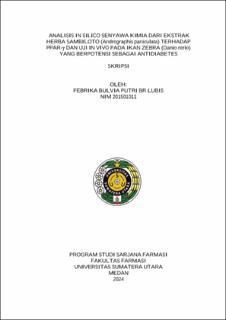| dc.contributor.advisor | Marianne | |
| dc.contributor.advisor | Wahyuni, Henny Sri | |
| dc.contributor.author | Lubis, Febrika Bulvia Putri Br | |
| dc.date.accessioned | 2024-09-10T09:02:47Z | |
| dc.date.available | 2024-09-10T09:02:47Z | |
| dc.date.issued | 2024 | |
| dc.identifier.uri | https://repositori.usu.ac.id/handle/123456789/97064 | |
| dc.description.abstract | Background: Diabetes was chronic metabolic disease characterized by hyperglycemia. Herbs sambiloto contains andrographolide and flavonoid compounds were thought to be a treatment for diabetes mellitus with PPAR-γ receptors by increasing insulin sensitivity so that in silico and in vivo testing was needed.
Objective: This study aims to determine the secondary metabolites of ethanol extract of herbs sambiloto against PPAR-γ receptors that had potential as antidiabetics in silico and in vivo.
Methods: In silico antidiabetic testing was carried out in several stages, namely the analysis of chemical compounds from ethanol extracts of sambiloto herb with LC-HRMS/MS, prediction of biological activity (PASS online), physicochemistry (Drug design Lipinski), pharmacokinetics (SwissADME), toxicity (ProTox-II), molecular tethering (Autodock tools and Autodock Vina). In the in vivo antidiabetic testing, zebrafish was used as a test animal model with the measurement parameter of zebrafish blood glucose levels.
Results: Based on the results of the research that had been done, from the results of the LC-HRMS/MS test on the ethanol extract of sambiloto herb obtained 25 compounds followed by in silico tests so that the chemical compounds obtained from the ethanol extract of sambiloto herb have interactions with PPAR-γ receptors by looking at the binding affinity value and having similar amino acid residues with native ligand and comparator and some supporting predictions. In vivo showed that the ethanol extract of herba sambiloto with a concentration of 400 mg/2l can reduced blood glucose levels in zebrafish which was close to the positive control group and had a significant difference with the negative control group (P < 0.0001).
Conclusion: The chemical compounds of ethanol extract of herbs sambiloto had potential as antidiabetic, by fulfilling several testing parameters in silico and herbs sambiloto ethanol extract can reduced blood glucose levels in zebrafish in vivo. | en_US |
| dc.language.iso | id | en_US |
| dc.publisher | Universitas Sumatera Utara | en_US |
| dc.subject | Diabetes mellitus | en_US |
| dc.subject | Andrographis paniculata | en_US |
| dc.subject | PPAR-γ | en_US |
| dc.subject | Danio rerio | en_US |
| dc.subject | SDGs | en_US |
| dc.title | Analisis In Silico Senyawa Kimia Dari Ekstrak Herba Sambiloto (Andrographis paniculata) terhadap PPAR-γ dan Uji In Vivo pada Ikan Zebra (Danio rerio) yang Berpotensi sebagai Antidiabetes | en_US |
| dc.title.alternative | In Silico Analysis of Chemical Compounds from Herba Sambiloto Extract (Andrographis paniculata) Against PPAR-γ and In Vivo Test in Zebrafish (Danio rerio) with Potential as Antidiabetic | en_US |
| dc.type | Thesis | en_US |
| dc.identifier.nim | NIM201501011 | |
| dc.identifier.nidn | NIDN0020058001 | |
| dc.identifier.nidn | NIDN0122098503 | |
| dc.identifier.kodeprodi | KODEPRODI48201#Farmasi | |
| dc.description.pages | 199 Pages | en_US |
| dc.description.type | Skripsi Sarjana | en_US |


